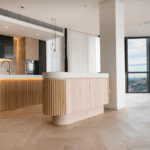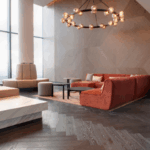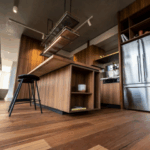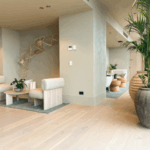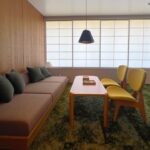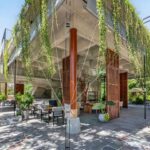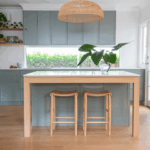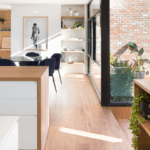Timber Flooring for High-Traffic Commercial Environments
Timber flooring continues to be a defining material in Australian commercial design, valued for its warmth, acoustics and architectural presence. In high-traffic environments such as hotel lobbies, public walkways, education facilities, office circulation zones and mixed-use developments, the performance requirements shift from purely aesthetic considerations to a balanced evaluation of durability, abrasion resistance and long-term visual stability.
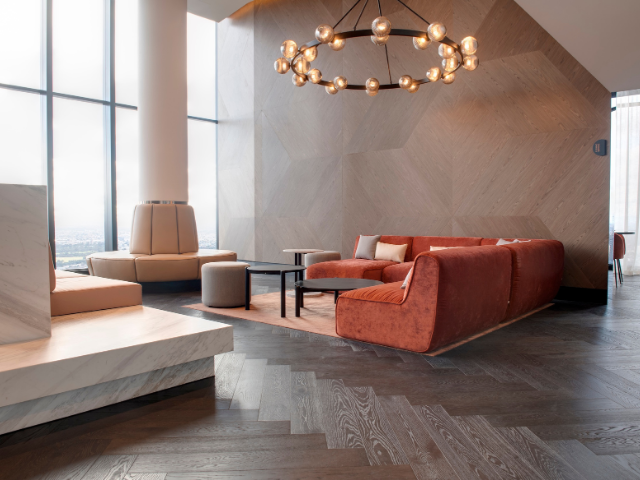
GALLERY
For specifiers, understanding the interplay between timber species, finish technology and colour selection is essential to achieving a resilient and commercially viable outcome.
A timber’s species hardness, measured by the Janka rating, is one of the most credible indicators of its ability to withstand consistent pedestrian activity, trolley movement, rolling loads and the abrasive grit carried in from outdoor environments. Harder, denser Australian hardwoods remain among the most durable choices for commercial applications. Grey Ironbark is renowned for its exceptional density and structural resilience, providing strong resistance against compression and surface wear, which makes it particularly suitable for spaces with continuous footfall. Spotted Gum performs similarly well, with an interlocking grain pattern and natural colour variation that diffuses wear lines and helps maintain visual integrity across long corridors and open-plan spaces. Tallowwood offers impressive durability due to its natural oils, which provide a slightly lubricated surface that resists scuffing, while Blackbutt achieves a balance of strength and lighter aesthetics that reduce the visibility of fine scratches and dust.
European Oak, although softer than Australia’s native hardwoods, remains one of the most specified timbers in commercial projects because of its versatility and unlimited potential for stylistic expression. When paired with a matte or wire-brushed coating, European Oak delivers excellent “visual durability,” often outperforming harder species in terms of how well it disguises superficial wear. By contrast, Tasmanian Oak is notably softer and, unless finished with high-performance coatings or used in lower-traffic zones, is typically better suited to residential or light-use commercial settings.
In commercial applications, the surface finish often has a greater impact on day-to-day appearance than the species itself. Matte finishes perform exceptionally well in high-use spaces because their low reflectivity diminishes the visibility of micro-scratches, scuffs and cleaning streaks. Wire-brushed matte surfaces enhance this effect through subtle texturing that naturally masks wear and simultaneously improves slip resistance, an important consideration in public-facing environments or workplaces where safety and maintenance efficiency are critical. Smooth matte or satin coatings offer a refined, contemporary finish while still providing adequate forgiveness in busy areas, whereas gloss finishes highlight every imperfection and are rarely suitable for spaces with heavy foot traffic.
Colour and grain characteristics also significantly influence the perception of wear, even though they do not alter the underlying durability of the timber. Light and mid-tone timbers are generally the most forgiving in commercial projects, as they hide dust, minor abrasion and traffic patterns while contributing to brighter, visually open spaces. Species with intrinsic variation, such as Spotted Gum and Tallowwood, naturally disrupt wear patterns and maintain visual consistency across extensive floor areas. Darker timbers, while elegant, tend to reveal superficial marks more readily and can increase maintenance requirements, especially in hospitality and corporate settings where appearance must be consistently maintained.
For commercial environments where longevity is paramount, the most effective specification typically combines a hardwearing species, a matte or wire-brushed finish and a light-to-mid-tone colour palette. This combination provides both structural resilience and strong visual performance over time. European Oak, when finished appropriately, offers excellent surface-level durability despite its softer classification, while Australian hardwoods such as Grey Ironbark, Spotted Gum and Blackbutt remain unmatched in overall wear resistance. Performance can be enhanced further through thoughtful detailing and maintenance planning. Entry mats and zoning systems reduce abrasive grit, appropriate furniture glides prevent point loading, and well-documented cleaning protocols aligned with the coating technology help maintain the timber’s surface over its lifespan. Substrate preparation, humidity control and installation practices also play significant roles in ensuring the flooring remains stable and visually cohesive throughout the life of the project.
With a considered selection of species, finish and colour, timber flooring can perform exceptionally well in commercial environments, offering a durable and architecturally rich solution that balances practicality with aesthetic ambition.
Visit Embelton Commercial to specify enduring quality in your next project.
Timber flooring continues to be a defining material in Australian commercial design, valued for its warmth, acoustics and ...
In Japan’s Mie Prefecture, a significant piece of modernist heritage has been given new life. The former Ueno ...
Khoan + Partners has reimagined an unfinished concrete structure in Cambodia as Phum Sambo Café & Eatery, a ...
Timber floors are one of the secrets to transforming any space into something truly special. When creating any ...
For over 100 years, Embelton has shaped Australia’s built environment, delivering quality flooring solutions for some of the ...

